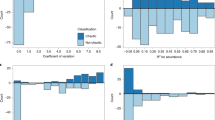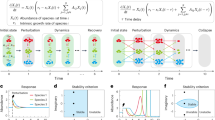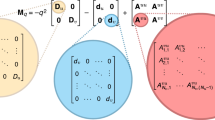Abstract
IN the mid-1970s, theoretical ecologists were responsible for stimulating interest in nonlinear dynamics and chaos1–3. Ironically, the importance of chaos in ecology itself remains controversial4–17. Proponents of ecological chaos point to its ubiquity in mathematical models and to various empirical findings15,16,18. Sceptics12,19,20 maintain that the models are unrealistic and that the experimental evidence is equally consistent with stochastic models. More generally, it has been argued9,11,21,23 that interdemic selection and/or enhanced rates of species extinction will eliminate populations and species that evolve into chaotic regions of parameter space. Fundamental to this opinion is the belief24,25 that violent oscillations and low minimum population densities are inevitable correlates of the chaotic state. In fact, rarity is not a necessary consequence of complex dynamical behaviour26,27. But even when chaos is associated with frequent rarity, its consequences to survival are necessarily deleterious only in the case of species composed of a single population. Of course, the majority of real world species (for example, most insects) consist of multiple populations weakly coupled by migration, and in this circumstance chaos can actually reduce the probability of extinction. Here we show that although low densities lead to more frequent extinction at the local level28, the decorrelating effect of chaotic oscillations reduces the degree of synchrony among populations and thus the likelihood that all are simultaneously extinguished.
This is a preview of subscription content, access via your institution
Access options
Subscribe to this journal
Receive 51 print issues and online access
$199.00 per year
only $3.90 per issue
Buy this article
- Purchase on Springer Link
- Instant access to full article PDF
Prices may be subject to local taxes which are calculated during checkout
Similar content being viewed by others
References
May, R. M. Science 186, 645–647 (1974).
May, R. M. Nature 216, 459–467 (1976).
May, R. M. & Oster, G. F. Am. Nat. 110, 573–599 (1976).
Hassell, M. P., Lawton, J. H. & May, R. M. J. Anim. Ecol. 45, 473–486 (1976).
Schaffer, W. M. & Kot, M. Trends Ecol. Evol. 1, 58–63 (1986).
Nisbet, R. M., Blythe, S. & Gurney, W. S. C. Trends Ecol. Evol. 4, 238–239 (1989).
Mani, G. S. Trends Ecol. Evol. 4, 239–240 (1989).
Lomnicki, A. Trends Ecol. Evol. 4, 239 (1989).
Berryman, A. A. in Chaos in Ecology (eds Logan, J. A. & Hain, F. P.) 23–38 (VA Exp. Sta. Inf. Series 91–93, Blacksburg, VA, 1991).
Morris, W. F. Ecology 71, 1849–1862 (1990).
Berryman, A. A. & Millstein, J. A. Trends Ecol. Evol. 4, 26–28 (1989).
Ellner, S. in Chaos in Ecology (eds Logan, J. A. & Hain, F. P.) 63–90 (VA Exp. Sta. Inf. Series 91–93, Blacksburg, VA, 1991).
Sugihara, G. & May, R. M. Nature 344, 734–741 (1990).
Turchin, P. Nature 344, 660–663 (1990).
Turchin, P. in Chaos in Ecology (eds Logan, J. A. & Hain, F. P.) 39–62 (VA Exp. Sta. Inf. Series 91–93, Blacksburg, VA, 1991).
Turchin, P. & Taylor, A. Ecology 73, 289–305 (1992).
Logan, J. A. & Allen, J. C. A. Rev. Ent. 37, 455–477 (1992).
Tillman, D. & Wedin, D. Nature 353, 653–655 (1991).
Casdagli, M. Physica D. 35, 335–356 (1989).
Ruelle, D. Proc. R. Soc. Lond. A 427, 241–248 (1990).
Thomas, W. R., Pomerantz, M. J. & Gilpin, M. E. Ecology 61, 13–17 (1980).
Mueller, L. D. & Ayala, F. J. Ecology 62, 1148–1154 (1981).
Philippi, T. E., Carpenter, M. P., Case, T. J. & Gilpin, M. E. Ecology 68, 154–159 (1987).
Vandermeer, J. Ecology 63, 1167–1168 (1982).
Vandermeer, J. Theor. Pop. Biol. 22, 17–27 (1982).
Rogers, T. D. Math. Biosci. 72, 13–17 (1984).
Milton, J. G. & Belair, J. Theor. Pop. Biol. 37, 273–289 (1990).
Pimm, S. L., Jones, J. L. & Diamond, J. Am. Nat. 132, 757–785 (1988).
Iwasa, Y. & Roughgarden, J. Theor. Pop. Biol. 30, 194–214 (1986).
Roughgarden, J. & Iwasa, Y. Theor. Pop. Biol. 29, 235–261 (1986).
Gilpin, M. E. & Hanski, I. Metapopulation Dynamics: Empirical and Theoretical Investigations (Academic, London, 1991).
Ruelle, D. Ann. N. Y. Acad. Sci. 316, 408–416 (1979).
Ricker, W. E. J. Fish. Res. Bd. Canada 11, 559–623 (1954).
Collet, P. & Eckmann, J.-P. Iterated Maps on the Interval as Dynamical Systems (Birkhaüser Boston, 1980).
Crutchfield, J. P., Farmer, J. D. & Huberman, B. A. Phys. Rev. 92, 45–82 (1982).
Lichtenberg, A. J. & Lieberman, M. A. Regular and Stochastic Motion (Springer, New York, 1983).
Yorke, J. A., Nathanson, N. Pianigiani, G. & Martin, J. Am J. Epidem. 109, 103–122 (1979).
Hassell, M. P., Comins, H. N. & May, R. M. Nature 353, 255–258 (1991).
Author information
Authors and Affiliations
Rights and permissions
About this article
Cite this article
Allen, J., Schaffer, W. & Rosko, D. Chaos reduces species extinction by amplifying local population noise. Nature 364, 229–232 (1993). https://doi.org/10.1038/364229a0
Received:
Accepted:
Issue Date:
DOI: https://doi.org/10.1038/364229a0
This article is cited by
-
Optimal dispersal and diffusion-enhanced robustness in two-patch metapopulations: origin’s saddle-source nature matters
Theory in Biosciences (2024)
-
Schooling behavior driven complexities in a fear-induced prey–predator system with harvesting under deterministic and stochastic environments
Scientific Reports (2023)
-
Robust Output Feedback Controller Design Based on Kalman Filter for Switched Positive Discrete-Time Systems
Circuits, Systems, and Signal Processing (2023)
-
Estimation of the present status of the species based on the theoretical bounds of environmental noise intensity: An illustration through a big abundance data and simulation
Theoretical Ecology (2022)
-
Moderate parasitoidism on pollinators contributes to population oscillations and increases species diversity in the fig-fig wasp community
Theoretical Ecology (2020)
Comments
By submitting a comment you agree to abide by our Terms and Community Guidelines. If you find something abusive or that does not comply with our terms or guidelines please flag it as inappropriate.



